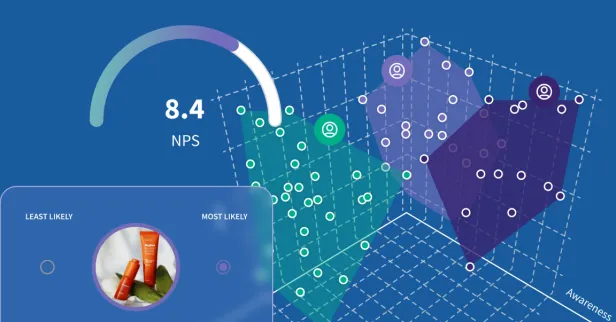For over a decade, the Net Promoter Score (NPS) has been one of the most widely used metrics in market research. And for good reason, as it allows companies to more tangibly measure their customer satisfaction and loyalty.
When earlier methods of calculating and quantifying customer satisfaction fell short, a Bain & Company team led by Fred Reichheld set out to find a new approach that would drive actionable results. That's when they found that a single question correlated most strongly with purchasing and referral behaviors. That question became the foundation of the NPS.
What is a Net Promoter Score (NPS)?
A Net Promoter Score is a measure used to gauge customer loyalty, satisfaction, and enthusiasm for a brand. It accomplishes this by asking respondents a simple question: "On a scale from 0-10, how likely are you to recommend this product (or company) to a friend or colleague?"
This metric is often considered the gold standard for customer experience, used by millions of organizations to measure and track how they're perceived by their customers.
Why NPS Measurement is Crucial
While simple, your net promoter score can be used to measure customer satisfaction and how likely a customer is to recommend your business to family and friends. Similarly, it can be used to gauge and predict customer loyalty- making it a crucial metric for any and every business.
NPS measurement is one of the most straightforward ways to understand how your brand fairs with consumers. And because it’s an easy metric to evaluate, you can easily benchmark and track your brand’s public perception over time.
As you come to better understand your NPS score and its key drivers, you can learn how to improve your business. Allowing you to build stronger relationships with your current customers and grow your loyalty with new audiences, building an ever-growing base of brand advocates.
Whatsmore, your net promoter score is also a great indicator of your future growth. According to research by Bain & Company, an industry’s net promoter leader will outgrow its competitors by a factor greater than 2x on average.
How to Calculate a Net Promoter Score (NPS)
Determining your net promoter score is nearly as easy as collecting the data.
In your NPS Survey, you will ask your customers the question: “On a scale of 0 to 10, how likely are you to recommend our business to family, friends, or colleagues?” Based on the rating each customer gives you, they can be classified into one of three groups:
Promoters
Promoters are those respondents who rated your company a 9 or 10. These are your loyal customers- they love your products, services, and business as a whole. They are often repeat buyers and will happily recommend you to other potential buyers.
Passives
Passives are the respondents who rated your company a 7 or 8. These are the customers marginally satisfied with your company, but not enough to be loyal repeat buyers. Similarly, they are not entirely dissatisfied- making them unlikely to speak positively or negatively about your brand.
Detractors
Detractors are the respondents who rated your company a 0 to 6 on a 10-point scale. As the name would suggest, they are not pleased with your products, services, or brand. They are likely to spread negative word of mouth and are unlikely to purchase from you again.
Once the feedback is collected, your NPS calculation can be done by subtracting the percentage of detractors from the percentage of promoters. You will come up with a number between -100 and 100.
 Tip: Consider adding an optional open-ended text response after your NPS question- it allows customers to provide you with context surrounding their rating and can be analyzed with Natural Language Processing (NLP) for sentiment analysis.
Tip: Consider adding an optional open-ended text response after your NPS question- it allows customers to provide you with context surrounding their rating and can be analyzed with Natural Language Processing (NLP) for sentiment analysis.
NPS Industry Benchmarks
If you're wondering what is considered a "good" net promoter score- you're not alone!
While there is no catch-all NPS benchmark, research shows that there are a range of net promoter scores considered average within each industry.
For example, SaaS platforms generally average an NPS of 30, while service-based businesses like cable TV or internet often bring in an NPS of -2 or -3.
In order to fully understand where your net promoter score falls, it's best to do a little research on your industry. While not necessarily drastic, benchmarks can change year to year- so make sure you find the latest data!
Best Practices for Launching Your NPS Survey
Overall, launching your own NPS survey is quite simple, but there are still a few key items you should keep in mind:
_Size=sm)_Color=Success.png) Include the Right Questions
Include the Right Questions
Outside of the obvious, there are a few additional questions you may want to include in your NPS survey. A few demographic and/or screening questions will allow you to better understand how different customer segments respond to your offerings. With this information, you can identify common issues with particular buyer personas or discover the persona that typically matches a 9-10 rating. Additionally, you may also want to consider an open-ended follow-up question directly after your NPS rating to find out why customers gave the response they did.
Context is Key
Make sure that you send out your NPS survey at the right time. Do not bombard brand new customers- give them time to explore your brand and get to know your product. If you reach out too early, the feedback won't be as valuable. While the exact timing will be different for every company, wait until customers have some time to enjoy your product or activate an important feature.
Test Frequently
One of the main benefits of the net promoter score is the ability to track it over time. To truly improve your NPS, it’s crucial to run experiments often and benchmark your progress over time- but don't overdo it. By reaching out at regular intervals, you may find that your detractors become passives and your passives may become promoters given time and exposure.
Close the Loop
It should go without saying, but the data you get from your NPS survey won't do you much good if you do not take action. When you survey your customers, make sure that they understand how you intend to use this information to improve your product, brand, marketing, etc. If you receive negative feedback from a customer, reach out with follow-up questions to better understand their problem. This is not only a great way to mend the relationship, but it also allows your organization to improve.
Choose the Right Research Platform
Choosing a platform for your NPS study is crucial. An end-to-end solution that provides both flexibility and support will markedly streamline your research. For analyzing the text of your open-ended follow-up question, NLP functionality will enable you to analyze your results by topic, keyword, theme, or sentiment to uncover trends, opportunities, or possible problems.
NPS Surveys with SightX
The SightX platform is the next generation of consumer insights tools: a single, unified solution for engagement, understanding, advanced analysis, and reporting.
If you're ready to turn your customer feedback into growth, SightX has the tools you need to launch NPS surveys, calculate your score, and benchmark your NPS over time. Reach out for a Demo to learn more!
